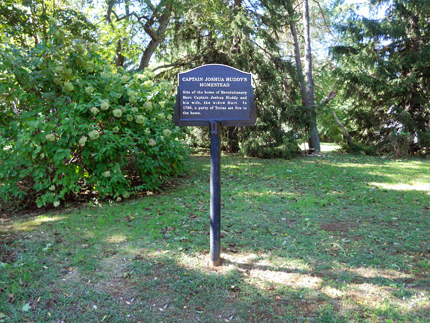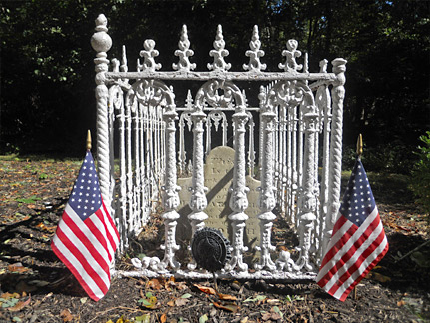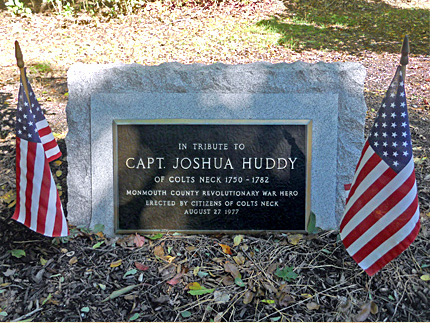



Captain Joshua Huddy's Homestead Site
Rte. 34 & Rte. 537
Map / Directions to Captain Joshua Huddy's Homestead Site
Map / Directions to all Colts Neck Revolutionary War Sites
Joshua Huddy
Captured at his Home at this Site, September, 1780
This sign marks the site of the home of Joshua Huddy, who served as a militia captain in the Revolutionary War. Huddy was captured here in September 1780 by a raiding party of Tories (Americans who remained loyal to the British in the Revolutionary War). The raiders attacked the house before dawn. Huddy held them off for a while, but he surrendered when the raiders set fire to the house. Huddy's captors took him to Shrewsbury River with the intention of taking him by boat through Sandy Hook bay to New York City (which at that time, and for most of the Revolutionary War, was in British hands). However, they had been pursued by militiamen who fired at the boat from the riverbank in what is now Rumson. The boat capsized, and Huddy received a bullet wound in the thigh. Even with the wound, Huddy escaped by swimming to shore. [1]
Huddy Recaptured at the Toms River Blockhouse — March 24, 1782,
and Hanged in Highlands on April 12
Huddy was placed in command of the Toms River blockhouse on February 1, 1782. A blockhouse is a small defensive fort; the blockhouse at Toms River had been built to protect the local salt works. In the time before modern refrigeration, salt was an important commodity because it was used as the main method of preserving food.
A raiding party of about 100 Tories attacked the blockhouse at Toms River on March 24. Huddy and his men surrendered when they ran out of ammunition. The Tory raiding party then burnt the village of Toms River; only two houses survived. Huddy and several of his men were taken prisoner. [2] This time, Huddy captors succeeded in taking him to New York, where he was sentenced to be executed.
On April 12, Huddy was hanged in Highlands by a group of men under the command of Captain Richard Lippincott. Huddy's hanging was considered as revenge for Phillip White, a Tory who had been killed while in American custody. To emphasize their revengeful intentions, a note was put on Huddy's chest by his executioners which included the phrase, "Up Goes Huddy for Phillip White." [3] In reality, White's killing had actually occurred after Huddy's capture, so Huddy had no connection with it.
The Asgill Affair
Huddy's execution sparked a controversy known as the Asgill Affair. It began when hundreds of local citizens protested Huddy's hanging and sent a petition demanding retribution for the execution to General Washington. Since Captain Lippincott, under whose direction Huddy had been hanged, was a British officer behind British lines, the Americans had no way to apprehend him.
As a result, Charles Asgill, a young British officer in American custody, was chosen by lot to be executed unless the British turned over Lippincott to the Americans. This was very controversial. To begin with, Asgill was completely innocent — he had nothing to do with the hanging of Huddy, and had in fact been held prisoner by the Americans since he was one of the British troops who surrendered at the Battle of Yorktown, which took place six months before Huddy's hanging. Furthermore, Asgill's execution would violate the terms of surrender at the Battle of Yorktown, under which retaliation was forbidden. George Washington was greatly troubled by the injustice of executing Asgill, and he hoped to find a way to avoid it. [4]
With all this in mind, Washington wrote to the British Commander, General Henry Clinton, on April 21, 1782. He demanded that Captain Lippincott, under whose direction Huddy had been hanged, be turned over to the Americans. Included with the letter were testimonials of Monmouth County residents regarding the facts of Huddy's execution. The complete text of Washington's letter appears below:[5]
(Note that the spelling and punctuation in this letter have not been modernized or corrected.)
Sir
The inclosed representation from the Inhabitants of the County of Monmouth, with testimonials to the facts, which can be coroborated by other unquestionable evidence, will bring before your Excellency the most wanton, unprecedented, & inhuman Murder that ever disgraced the arms of a civilized People.
I shall not, because I conceive it altogether unnecessary, trouble your Excellency with any animadversion upon this transaction. Candor obliges me to be explict. To save the innocent, I demand the guilty—Captain Lippingcot, therefore or the officer who commanded at the execution of Captain Huddy must be given up; or, if that Officer was of inferior rank to him, so many of the perpetrators, as will, according to the Tariff of Exchange be an Equivalent.
To do this will mark the justice of your Excellency’s Character—in failure of it, I shall hold myself justifiable in the Eyes of God & Man for the measure to which I shall resort.
I beg your Excellency to be perswaded that it cannot be more disagreable to you to be addressed in this Language than it is to me to offer it, but the subject requires frankness and decision.
I have to request your speedy determination, as my resolution is suspended but for your answer. I have the honor to be Sir Your Excellency’s most Obedient & most humble servant
Go: Washington
Rather than turn over Lippincott to the Americans, the British held a court-martial to determine if Richard Lippincott was guilty of the murder of Joshua Huddy. Lippincott was found not guilty because "altho' Joshua Huddy was executed without proper Authority," Lippincott believed that he was acting under proper orders. [6]
Meanwhile, Asgill remained a prisoner, uncertain of whether the execution sentence would be carried out. Asgill came from a prominent British family. His father had been the Mayor of London in 1757-1758. During Asgill''s captivity, his mother wrote to the French Foreign Minister Charles Gravier asking him to intervene in the matter. (France was an important ally of the Americans in the Revolutionary War.) Gravier in turn wrote to George Washington asking that Asgill be spared. Washington forwarded the letter to Congress. [7]
An Act of Congress freed Asgill on November 7, 1782. [8] Six days later, Washington wrote to Asgill informing him that he was being set free.[9]
Captain Joshua Huddy is buried at the Old Tennent Church in Manalapan. [10] Huddy's home, which had survived being set ablaze by a party of Tories in 1780, was torn down in 1842. The historic sign on Rte. 34, just off Rte. 537, marks the site of the house. [11]
After the war, Captain Lippincott, under whose direction Huddy had been hanged, settled in Canada, where the British rewarded him with 3,000 acres of land for remaining loyal during the war. Although Lippincott fought for the British, he was from Monmouth County, having been born in Shrewsbury. He was a Loyalist who served with the British army for most of the war. [12]



The Colts Neck Inn
Rte. 34 & Rte. 537
Map / Directions to the Colts Neck Inn
Map / Directions to all Colts Neck Revolutionary War Sites
The Colts Neck Inn, which is across the street from the Huddy Homestead site, dates to circa 1717. It was owned by Joshua Huddy's widow, Catherine Applegate Hart. [13] Catherine was Huddy's second wife. They were married October 27, 1778. [14]
The building is still in use as a restaurant known as the Colts Neck Inn Steak & Chop House.





Colts Neck Memorial Park
Private Michael Field Gravesite
Joshua Huddy Memorial
Heyers Mill Rd. near Deep Wood Ln.
Map / Directions to Colts Neck Memorial Park
Map / Directions to all Colts Neck Revolutionary War Sites
Colts Neck Memorial Park was created around the grave of Revolutionary Private Michael Field. The original grave and gravestone are fenced in a small area by decorative white rails. A nearby marker explains:
"Private Michael Field — 1st Reg. N.J. Militia. Born in Bound Brook N.J. Aug. 30, 1758. Wounded and captured in the Battle of Monmouth Court House. Left in this area by the British in their retreat. Whether he died of his wounds or was slain by his captors is not known. Died June 28, 1778." [15]
The park also has a small memorial to Captain Joshua Huddy.
In addition to the Revolutionary War items in the park, there is also a memorial to the World War II soldiers of Colts Neck.

1. ^ "Letter from Monmouth (New Jersey) to a Gentleman in this City," Pennsylvania Packet, October 3, 1780, page 2
Contains an account of these events, which it states was "taken from Captain Huddy himself." The writer of the letter is unidentified.In the main entry above, these events are described as occurring in "September 1780." No day of the month is included because there is some confusion about the date:
The "Letter from Monmouth (New Jersey) to a Gentleman in this City," states that the events occurred "On Sunday morning, the 9th instant" [meaning the 9th of the current month, September]. This must have been a mistake by the letter writer or by the typesetter, because September 9, 1780 was a Saturday. September 3 and 10 fell on a Sunday in 1780.
The Huddy's Leap monument in Rumson has a plaque which states that the events occurred on September 1, 1780. Although the plaque does not mention it, September 1, 1780 was a Friday. This plaque was placed by the Rumson Improvement Association in 1957.
2. ^ "Extract of a letter from Monmouth, March 25 [1782]," New Jersey Gazette, Vol. V., No. 222, March 27, 1782,
reprinted in:
Austin Scott, Editor, Archives of the State of New Jersey, Second Series, Vol. V. (Trenton, Star Gazette Publishing Company, 1917) Pages 400 — 401
Available to be read at the Internet Archive here3. ^ The full text of the note appears in:
"Freehold, Monmouth county, dated April 15, 1782," New Jersey Gazette, Vol. V., No. 226, April 24, 1782,
reprinted in:
Austin Scott, Editor, Archives of the State of New Jersey, Second Series, Vol. V. (Trenton, Star Gazette Publishing Company, 1917) Pages 424 — 425
Available to be read at the Internet Archive here4. ^ “To George Washington from Moses Hazen, 27 May 1782,” Founders Online, National Archives ( http://founders.archives.gov/documents/Washington/99-01-02-08533 http://founders.archives.gov/
documents/Washington/
99-01-02-08533 [last update: 2015-09-29]). Source: this is an Early Access document from The Papers of George Washington. It is not an authoritative final version.“From George Washington to Benjamin Lincoln, 5 June 1782,” Founders Online, National Archives ( http://founders.archives.gov/documents/Washington/99-01-02-08621 http://founders.archives.gov/
documents/Washington/
99-01-02-08621 [last update: 2015-09-29]). Source: this is an Early Access document from The Papers of George Washington. It is not an authoritative final version.5. ^ “From George Washington to Henry Clinton, 21 April 1782,” Founders Online, National Archives ( http://founders.archives.gov/documents/Washington/99-01-02-08216 http://founders.archives.gov/
documents/Washington/
99-01-02-08216 [last update: 2015-09-29]). Source: this is an Early Access document from The Papers of George Washington. It is not an authoritative final version.• Another interesting letter on the Asgill/Lippincott situation was written by Thomas Paine to Clinton's successor, General Guy Tarleton. It appeared in the New Jersey Gazette, Vol. V., No. 233, June 12, 1782. Paine signed the letter "Common Sense."
Reprinted in:
Austin Scott, Editor, Archives of the State of New Jersey, Second Series, Vol. V. (Trenton, Star Gazette Publishing Company, 1917) Pages 450–453
Available to be read at the Internet Archive here.6. ^ Information about the court-martial and the "altho' Joshua Huddy was executed without proper Authority" quote were drawn from:
Court Martial of Capt. Richard Lippincott 1782 Proceedings of a General Court Martial held at the City Hall in New York in the Province of New York, from Friday the 3d May to Saturday the 22d June 1782 for the Tryal [sic] of Captain Richard Lippincott.
Available as part of the Provincial Archives of New Brunswick, Canada here.
The finding of Not Guilty appears near the end of the document and reads,
"The Court having considered the Evidence for and against the Prisoner, Captain Richard Lippincott, together with what he had to offer in his Defence, and it appearing that (altho' Joshua Huddy was executed without proper Authority) What the Prisoner did in the Matter was not the Effect of Malice or Ill-will, but proceeded from a Conviction that it was his Duty to obey the Orders of the Board of Directors of Associated Loyalists, and his not doubting their having a full Authority to give such Orders, the Court is of Opinion that he, the Prisoner, Captain Richard Lippincott, is Not Guilty of the Murder laid to his Charge, and doth therefore Acquit him."7. ^ “To George Washington from Charles Gravier, comte de Vergennes, 29 July 1782,” Founders Online, National Archives ( http://founders.archives.gov/documents/Washington/99-01-02-08956 http://founders.archives.gov/
documents/Washington/
99-01-02-08956 [last update: 2015-09-29]). Source: this is an Early Access document from The Papers of George Washington. It is not an authoritative final version.“From George Washington to Charles Gravier, comte de Vergennes, 21 November 1782,” Founders Online, National Archives ( http://founders.archives.gov/documents/Washington/99-01-02-10002 http://founders.archives.gov/
documents/Washington/
99-01-02-10002 [last update: 2015-09-29]). Source: this is an Early Access document from The Papers of George Washington. It is not an authoritative final version.8. ^ The Revolutionary Diplomatic Correspondence of the United States, Volume 5 (Washington D.C.: Government Printing Office, 1889) page 870
Available to be read at Google Books here.9. ^ Six letters that were exchanged between Asgill and Washington during this period.
These six letters are available to be read at the National Archives website here.
▸ The final letter was sent by Washington to Asgill on November 13, informing Asgill that "It affords me singular pleasure to have it in my power to transmit you the inclosed Copy of an Act of Congress of the 7th instant, by which you are released from the disagreeable circumstances in which you have so long been — supposing you would wish to go into New York as soon as possible, I also inclose a passport for that purpose."
NOTE: In addition to the primary sources cited in notes 1 — 9, the following works were consulted about Joshua Huddy's story:
Gary D. Saretzky, Josiah Huddy and the American Revolution in New Jersey — Article is based on a presentation made by Monmouth County Archivist Gary D. Saretzky, to the Atlantic Highlands Historical Society on April 20, 2005.
Aavailable to be read here.William Scudder Stryker, The Capture of the Block House at Toms River, New Jersey, March 24, 1782: Read at the Memorial Service at Toms River, May 30, 1888 (Trenton: Naar, Day & Naar, 1883)
Available to be read at Google Books here.
10. ^ Gravestone information at the Old Tennent Church
11. ^ The historic sign marking this as the site of the Joshua Huddy Homestead site does not state who erected the sign. However, a document titled "BICENTENNIAL CHRONOLOGY By Date," compiled by Patrick Caiazzo and Gary D. Saretzky, Monmouth County Archives, 1997, states that this sign was placed here by the town of Colts Neck in June 1976.
This document is available at the Monmouth County website here.• Information about the original house surviving until 1842 was drawn from the article Joshua Huddy's Story, which was prepared for the members of the Captain Joshua Huddy Chapter of the Daughters of the American Revolution, by Virginia Watson Reeve, Organizing Regent of the Chapter, March 30, 1950. The article can be found at the Captain Joshua Huddy Chapter website here.
12. ^ Egerton Ryerson, The Loyalists of America and Their Times: From 1620 to 1816, Volume 2 (Toronto: William Briggs, James Campbell & Son, and Willing & Williamson, 1880) Pages 193-195
Available to be read at the Internet Archive here.13. ^ Circa 1717 date from the historic sign in front of the Colts Neck Inn
14. ^ Gary D. Saretzky, Josiah Huddy and the American Revolution in New Jersey — Article is based on a presentation made by Monmouth County Archivist Gary D. Saretzky to the Atlantic Highlands Historical Society on April 20, 2005.
A PDF of the article is available on the Hofstra University website here.15. ^ Plaque erected by Frank J. Cahir 1963